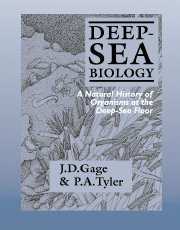Book contents
- Frontmatter
- Contents
- Preface
- Acknowledgements
- PART I The development of deep-sea biology, the physical environment and methods of study
- PART II Organisms of the deep-sea benthic boundary
- PART III Patterns in space
- PART IV Processes: patterns in time
- PART V Parallel systems and anthropogenic effects
- References
- Species index
- Subject index
PART III - Patterns in space
Published online by Cambridge University Press: 05 June 2012
- Frontmatter
- Contents
- Preface
- Acknowledgements
- PART I The development of deep-sea biology, the physical environment and methods of study
- PART II Organisms of the deep-sea benthic boundary
- PART III Patterns in space
- PART IV Processes: patterns in time
- PART V Parallel systems and anthropogenic effects
- References
- Species index
- Subject index
Summary
In the past, our information on the biology of the deep sea was traditionally gained from sampling designs worked on research ship cruises or expeditions having the aim of describing the composition of the fauna over vast areas of the ocean basins. The patterns revealed have necessarily been large in scale, and have addressed problems of the global and regional distributional of the fauna. Our ever-improving resolution of the physical structure of the deep sea, along with technical advances such as improvements in sampling gear and surface navigation, have permitted biologists to address a finer grain of variation, often along bathymetric transects. Such studies have involved quantitative sampling methods and bottom phototransects, allowing investigation of pattern in distribution of populations and communities associated with environmental gradients; the most important constituting one of the major environmental gradients on this planet, that relating to depth on the sloping parts of the seabed. We also consider in this section the effect on the distributional pattern of animals caused by other variation, principally that related to the amount and nature of organic material entering the deep sea, but also that related to local topographic and hydrodynamic conditions, such as canyons, seamounts and deep boundary currents.
In discussing these various sorts and scales of pattern we shall progress from the smallest to the largest scale with a discussion, in Chapter 6, of investigation of pattern at the scale of individual animals. Such study has only been made possible by means of observations and sampling from deep-diving manned and remote-controlled submersibles, and from small-scale, precisely positioned sample replication, made possible by modern navigation aids.
- Type
- Chapter
- Information
- Deep-Sea BiologyA Natural History of Organisms at the Deep-Sea Floor, pp. 163 - 164Publisher: Cambridge University PressPrint publication year: 1991

